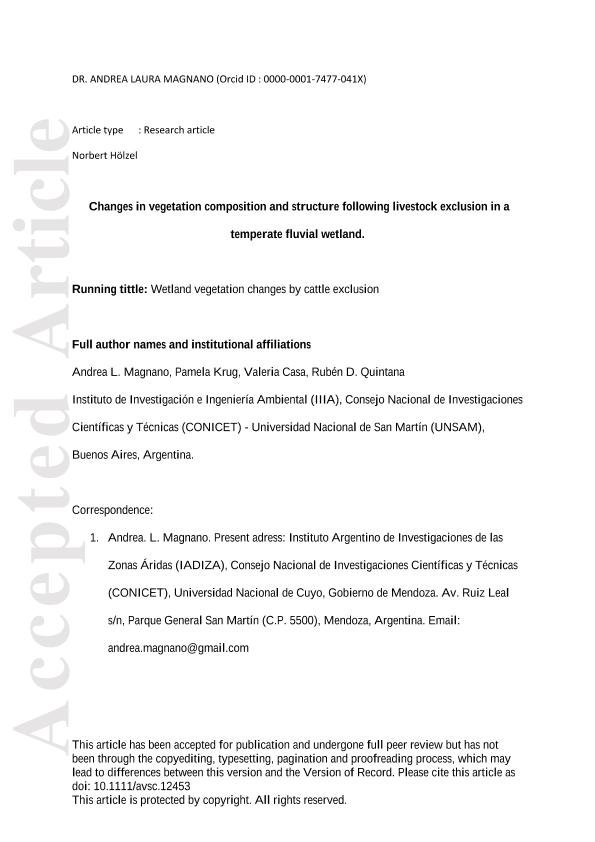Mostrar el registro sencillo del ítem
dc.contributor.author
Magnano, Andrea Laura

dc.contributor.author
Krug, Cecilia Pamela

dc.contributor.author
Casa, Valeria

dc.contributor.author
Quintana, Ruben Dario

dc.date.available
2021-01-29T12:18:00Z
dc.date.issued
2019-10
dc.identifier.citation
Magnano, Andrea Laura; Krug, Cecilia Pamela; Casa, Valeria; Quintana, Ruben Dario; Changes in vegetation composition and structure following livestock exclusion in a temperate fluvial wetland; Wiley Blackwell Publishing, Inc; Applied Vegetation Science; 22; 4; 10-2019; 484-493
dc.identifier.issn
1402-2001
dc.identifier.uri
http://hdl.handle.net/11336/124163
dc.description.abstract
Questions: Responses of wetland systems to grazing can be highly variable with both positive or negative responses. However, the sustainable use of wetlands for grazing will depend on the management implemented and the resilience of each type of them. In this context, we addressed the question: will the vegetation in the studied wetland be able to recover its structural and functional parameters in the short term after livestock exclusion?. Location: Temperate fluvial wetlands in the middle Delta of the Paraná River, Argentina, South America. Methods: We evaluated the effect of cattle ranching on vegetation composition and diversity by determining changes in species richness and evenness, biomass (green and dry vegetative, and reproductive biomass), and litter content. We also analyzed the changes in biomass of weeds and of species according to their forage quality, toxicity, and growth form. We applied a randomized block design (by topographic position) with repeated measures over time, using livestock exclusion as treatment. Results: After 16 months, livestock exclusion affected vegetation species richness, but did not have a significant effect on diversity due to a slightly compensatory effect of evenness. Species composition differed markedly among treatments over time. There was an increase in dry and green vegetative biomass and litter content after eight months of exclusion, while changes in reproductive biomass occurred later. The increase in these variables was closely related to changes in biomass of species with erect habit and good forage quality. Conclusions: Livestock exclusion increased the forage value for the studied wetland by the development of natural palatable species typical of these environments. This shift in species composition promoted a higher production in biomass in the ungrazed areas. This suggests a remarkable recovery of the structural and functional parameters of the vegetation communities in the short term (two years).
dc.format
application/pdf
dc.language.iso
eng
dc.publisher
Wiley Blackwell Publishing, Inc

dc.rights
info:eu-repo/semantics/openAccess
dc.rights.uri
https://creativecommons.org/licenses/by-nc-nd/2.5/ar/
dc.subject
ARGENTINA
dc.subject
BIOMASS
dc.subject
LIVESTOCK EXCLUSION
dc.subject
PARANÁ RIVER DELTA
dc.subject
RECOVERY
dc.subject
TEMPERATE WETLAND
dc.subject
VEGETATION DIVERSITY
dc.subject
WETLAND PLANTS
dc.subject.classification
Ecología

dc.subject.classification
Ciencias Biológicas

dc.subject.classification
CIENCIAS NATURALES Y EXACTAS

dc.title
Changes in vegetation composition and structure following livestock exclusion in a temperate fluvial wetland
dc.type
info:eu-repo/semantics/article
dc.type
info:ar-repo/semantics/artículo
dc.type
info:eu-repo/semantics/publishedVersion
dc.date.updated
2020-11-18T20:12:35Z
dc.journal.volume
22
dc.journal.number
4
dc.journal.pagination
484-493
dc.journal.pais
Reino Unido

dc.journal.ciudad
Londres
dc.description.fil
Fil: Magnano, Andrea Laura. Consejo Nacional de Investigaciones Científicas y Técnicas. Centro Científico Tecnológico Conicet - Mendoza. Instituto Argentino de Investigaciones de las Zonas Áridas. Provincia de Mendoza. Instituto Argentino de Investigaciones de las Zonas Áridas. Universidad Nacional de Cuyo. Instituto Argentino de Investigaciones de las Zonas Áridas; Argentina
dc.description.fil
Fil: Krug, Cecilia Pamela. Universidad Nacional de San Martín. Instituto de Investigación e Ingeniería Ambiental. - Consejo Nacional de Investigaciones Científicas y Técnicas. Oficina de Coordinación Administrativa Parque Centenario. Instituto de Investigación e Ingeniería Ambiental; Argentina
dc.description.fil
Fil: Casa, Valeria. Universidad Nacional de San Martín. Instituto de Investigación e Ingeniería Ambiental. - Consejo Nacional de Investigaciones Científicas y Técnicas. Oficina de Coordinación Administrativa Parque Centenario. Instituto de Investigación e Ingeniería Ambiental; Argentina
dc.description.fil
Fil: Quintana, Ruben Dario. Universidad Nacional de San Martín. Instituto de Investigación e Ingeniería Ambiental. - Consejo Nacional de Investigaciones Científicas y Técnicas. Oficina de Coordinación Administrativa Parque Centenario. Instituto de Investigación e Ingeniería Ambiental; Argentina
dc.journal.title
Applied Vegetation Science

dc.relation.alternativeid
info:eu-repo/semantics/altIdentifier/url/https://onlinelibrary.wiley.com/doi/abs/10.1111/avsc.12453
dc.relation.alternativeid
info:eu-repo/semantics/altIdentifier/doi/http://dx.doi.org/10.1111/avsc.12453
Archivos asociados
